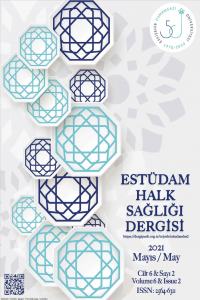DEVELOPMENT OF A SATISFACTION QUESTIONNAIRE FOR CANCER PATIENTS IN TURKEY - TÜRKİYE'DEKİ KANSER HASTALARI İÇİN MEMNUNİYET ANKETİ GELİŞTİRME
faktör analizi, hasta memnuniyeti, yapısal eşitlik modellemesi, kanser, Türkiye
DEVELOPMENT OF A SATISFACTION QUESTIONNAIRE FOR CANCER PATIENTS IN TURKEY - TÜRKİYE'DEKİ KANSER HASTALARI İÇİN MEMNUNİYET ANKETİ GELİŞTİRME
factor analysis, patient satisfaction, structural equation modelling, cancer, Turkey,
___
- 1. Teunissen, S.C., Wesker, W., Kruitwagen, C., de Haes, H.C., Voest, E.E., de Graeff, A. (2007). Symptom prevalence in patients with incurable cancer: a systematic review. Journal of Pain Symptom Management, 34(1), 94-104
- 2. Akin, S., Can, G., Aydiner, A., Ozdilli, K., Durna, Z. (2010). Quality of life, symptom experience and distress of lung cancer patients undergoing chemotherapy. Eur J Oncol Nurs, 14(5), 400-409
- 3. Barbera, L.,Seow, H.,Howell, D.,Sutradhar, R.,Earle, C.&Liu, Y. et al.,(2010). Symptom burden and performance status in a population‐based cohort of ambulatory cancer patients. Cancer,116(24), 5767-5776
- 4. Bağçivan, G., Tosun, N., Kömürcü, Ş., Akbayrak, N., Özet, A. (2009). Analysis of patient-related barriers in cancer pain management in Turkish patients. J Pain Symptom Manage, 38(5), 727-737
- 5. Cleeland, C.S., Mendoza, T.R., Wang, X.S. et al. (2000). Assessing symptom distress in cancer patients. Cancer, 89(7), 1634-1646
- 6. Stelfox, H.T., Gandhi, T.K., Orav, E.J., Gustafson, M.L. (2005). The relation of patient satisfaction with complaints against physicians and malpractice lawsuits. The American Journal of Medicine, 118, 1126–1133
- 7. Heyland, D.K., Cook, D.J., Rocker, G.M. et al. (2010). The development and validation of a novel questionnaire to measure patient and family satisfaction with end-of-life care: the Canadian Health Care Evaluation Project (CANHELP) Questionnaire. Palliative Medicine, 24(7), 682-695
- 8. Kristjanson, L.J. (1993). Validity and reliability testing of the FAMCARE Scale: measuring family satisfaction with advanced cancer care. Social Science & Medicine, 36(5), 693-701
- 9. Yabroff, K.R., Mandelblatt, J.S. & Ingham, J. (2004). The quality of medical care at the end-of-life in the USA: existing barriers and examples of process and outcome measures. Palliative Medicine, 18(3), 202-216
- 10. Brédart, A., Mignot, V., Rousseau, A. et al., (2004). Validation of the EORTC QLQ-SAT32 cancer inpatient satisfaction questionnaire by self-versus interview-assessment comparison. Patient Education and Counseling, 54(2), 207-212
- 11. Schafer, J.L. & Graham, J.W. (2002). Missing data: our view of the state of the art. Psychological Methods, 7, 147–77
- 12. Kline, R. (2005). Principles and Practice of Structural Equation Modeling. 2nd ed. New York, NY: The Guilford Press
- 13. MacCallum, R.C.&Austin, J.T. (2000). Applications of structural equation modeling in psychological research. Annual Review of Psychology, 51, 201–226
- 14. Jemal, A., Bray, F., Center, M.M., Ferlay, J., Ward, E., Forman, D. (2011). Global cancer statistics. CA: A Cancer Journal for Clinicians., 61(2), 69-90
- 15. Nunnally J & Bernstein I. (1994). Psychometric theory. 3rd ed. New York, NY: McGraw-Hill, Inc.
- 16. Beach, M.C., Sugarman, J., Johnson, R.L., Arbelaez, J.J., Duggan, P.S., Cooper, L.A. (2005). Do patients treated with dignity report higher satisfaction, adherence, and receipt of preventive care?. The Annals of Family Medicine, 3(4), 331-338
- 17. Moore, I.N., Snyder, S.L., Miller, C., Qui An, A. (2007). Confidentiality and Privacy in Health Care from the Patient's Perspective: Does HIPPA Help. Health Matrix, 17, 215
- 18. Heyland, D.K., Dodek, P., Rocker, G. et al.(2006). What matters most in end-of-life care: perceptions of seriously ill patients and their family members. Canadian Medical Association Journal, 174(5), 627-633
- 19. Guerriere, D.N., Zagorski, B., Fassbender, K., Masucci, L., Librach, L., Coyte, P.C. (2010). Cost variations in ambulatory and home-based palliative care. Palliative Medicine,24(5), 523-532
- 20. Ong, L.M., Visser, M.R., Lammes, F.B., de Haes, J.C. (2000). Doctor–patient communication and cancer patients’ quality of life and satisfaction. Patient Education and Counseling, 41(2), 145-156
- 21. Hudon, C., Fortin, M., Haggerty, J.L., Lambert, M., Poitras, M.E. (2011). Measuring patients’ perceptions of patient-centered care: a systematic review of tools for family medicine. The Annals of Family Medicine., 9(2), 155-164.
- ISSN: 2564-6311
- Yayın Aralığı: Yılda 3 Sayı
- Başlangıç: 2016
- Yayıncı: Eskişehir Osmangazi Üniversitesi
SAĞLIK TURİZMİ ÇERÇEVESİNDE TÜRKİYE’DE TERMAL TURİZM; BİR SWOT ANALİZİ ÇALIŞMASI
Demet Börekçi, Gürcan Paracıklı, Serap Çetin Çoban, Fehminaz Temel
Ece Elif ÖCAL, Burhanettin IŞIKLI
Ömer ATAÇ, Osman Erol HAYRAN, Alişan EMRECİKSİN
Ozan DEMİRÖZER, Asiye UZUN, Burak KURT, Tufan NAYİR, Dilek ÖZTAŞ, Tuğçe TERCAN
